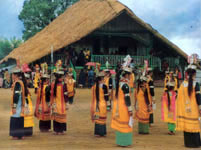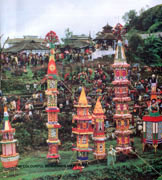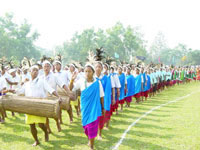Basic facts of Meghalaya
PRINCIPAL LANGUAGES
The principal languages in Meghalaya are Khasi and Garo with English as the official language of the State. It was at the initiative of the Christian missionaries that the Khasi and Garo languages and literature have developed and emerged in the list of Modern India Languages. Now Khasi and Garo languages is taught as one of the subjects of study upto to the Post Graduate level.
ADMINISTRATION
The State has a unicameral legislature. The Legislative Assembly consists of 60 Members - 29 from Khasi Hills, 7 from Jaintia Hills and 24 from Garo Hills.
Meghalaya originally comprised of two Districts and three Sub-Divisions. In order to accelerate the pace of development and to bring the administration closer to the people, the State has been reorganized into eleven administrative Districts and four Sub-divisions. For an all round development of the rural areas, the whole State is covered by 39 Community Development Blocks. There are three Autonomous District Councils in the State, namely the Khasi Hills Autonomous District Council, Garo Hills Autonomous District Council and Jaintia Hills Autonomous District Council. These councils discharge the functions and duties as assigned to them under the provisions of the Sixth Schedule of the Constitution of India
The functions and duties in each Council are discharged through the Executive, Legislative and Judiciary Wings.
The Members of the Councils are elected by the adult suffrage for a term of five years.
CULTURAL HERITAGE
Meghalaya is the homeland of three of India’s ancient hill communities, the Khasi, the Jaintias and the Garos. Dance, music and sports reflect their way of life. Festive sounds of merry making echo from hill to hill revealing the pulsating life of the tribal people. Mindful of their cultural heritage these simple folks are jovial and hospitable.
The people of Meghalaya are not of the same ethnic origin. The Khasis and Jaintias are believed to be remnants of the first Mongolian overflow into India. They established themselves in their present homeland in the remote past and, owing primarily to their geographical isolation, succeeded in maintaining their independence until the consolidation of the British administration in this part of India.
The Khasi language spoken by the Khasis and Jaintias is believed to be one of the very few surviving dialects of the Monkumer family of languages in India, today.
The Garo hills is the homeland of about ten lakhs of Garos who prefer to call themselves "Achik". Legend has is that the Garos originally inhabited a province of Tibet named Torua and left Tibet for some reason in the distant past under the leadership of the legendary Jappa-Jalimpa and Sukpa-Bongepa. They wandered in the Brahmaputra valley at the site of resent valley for centuries in search of a permanent home. In the process they survived the ordeals of wars and persecutions at the hand of the kings ruling the valley. They then branched out into a number of sub-tribes and the main body under the legendary leader, Along Noga, occupied Nokrek, the highest Peak in Garo Hills.
Linguistically, Garo is akin to Bodo or Kachari, which belongs to the Tibeto-Burman family of languages. They mainly practise jhum cultivation. Like the Khasi and Jaintias they are a matrilineal society. Life in the hills is hard, but these sturdy people are fond of dances, songs, sports and festivals.
FESTIVALS
 NONGKREM DANCE (POMBLANG NONGKREM) : - Pomblang Nongkrem popularly known as the Nongkrem Dance is one of the most important festivals of the Khasis. it is five day religious festival held annually at Smit about 11 Km from Shillong, the Headquarters of the Chief (Syiem) of Khyrim. This festival is celebrated as a thanksgiving to the God Almighty for the good harvest and to pray for peace and prosperity. The Syiem who is the Administrative Head of the Hima (Khasi State), Ka Syiem Sad (literally the Syiem priestess), who is the caretaker of all religious ceremonies of the Hima, the Myntri (Council of Ministers), the priest and the high priest and the people in general all join in this festival, which is a rhythmic form of prayer for the well being of all.
NONGKREM DANCE (POMBLANG NONGKREM) : - Pomblang Nongkrem popularly known as the Nongkrem Dance is one of the most important festivals of the Khasis. it is five day religious festival held annually at Smit about 11 Km from Shillong, the Headquarters of the Chief (Syiem) of Khyrim. This festival is celebrated as a thanksgiving to the God Almighty for the good harvest and to pray for peace and prosperity. The Syiem who is the Administrative Head of the Hima (Khasi State), Ka Syiem Sad (literally the Syiem priestess), who is the caretaker of all religious ceremonies of the Hima, the Myntri (Council of Ministers), the priest and the high priest and the people in general all join in this festival, which is a rhythmic form of prayer for the well being of all.
SHAD SUK MYNSIEM : - One of the most important festivals of the Khasis is ‘Ka Shad Suk Mynsiem’ (Dance of the joyful heart). It is a thanksgiving dance. Maidens dress in traditional fineries and menfolk in colourful costumes participate in the dance to the accompaniment of drums and the flute. It is held in Shillong in April every year. The festival last for 3 (three) days.
 BEH DIENKHLAM : - This is the most important festival of the Jaintias and is celebrated after the sowing is over. "Khlam" means ‘Plague or Pestilence’ and "Beh Dien" means to drive away with sticks. It is very popular and colourful festivals of the Jaintias where men only, young and old, take part in the dancing to the tune of drums and flute. Women do not take part in the dancing, but had an important role to play at home in offering sacrificial food to the spirits of the ancestors. They invoke their aid and intercession, so that life here below will be good and worthy for the next one above. Men go round the town and beat the roof of every house with bamboo poles calling upon the plague demon to leave the house. This is done early on the first day of the festival. The climax of the celebrations is the tussle, as seen in a tug of war, for a large undressed beam by two groups people opposed to each other. This festival is also an invocation to God, seeking His blessing for good harvest.
BEH DIENKHLAM : - This is the most important festival of the Jaintias and is celebrated after the sowing is over. "Khlam" means ‘Plague or Pestilence’ and "Beh Dien" means to drive away with sticks. It is very popular and colourful festivals of the Jaintias where men only, young and old, take part in the dancing to the tune of drums and flute. Women do not take part in the dancing, but had an important role to play at home in offering sacrificial food to the spirits of the ancestors. They invoke their aid and intercession, so that life here below will be good and worthy for the next one above. Men go round the town and beat the roof of every house with bamboo poles calling upon the plague demon to leave the house. This is done early on the first day of the festival. The climax of the celebrations is the tussle, as seen in a tug of war, for a large undressed beam by two groups people opposed to each other. This festival is also an invocation to God, seeking His blessing for good harvest.
 WANGALA DANCE : - This is the biggest of all festival of the Garos performed in collection with the Jhum cultivation. It is usually held in October and so sometimes synchronises with the Durga Puja, but each village sets its own time and so there are two or three weeks during which Wangala is celebrated in two or three villages. After harvest, the annual dance of joy and thanks giving commences. The occasion is initiated right in the field by a simple but impressive ceremony known as ‘Rugalal’, which is followed by the ceremony of incense known as ‘Sasat Soa’. This is performed inside the house of the Chief of the village. The Chief, amidst burning of incense, beating of drums and the chanting of the people, utter a few words of incantation and pour rice beer and sprinkles rice powder over a collection of field produce offered to the Gods. This is immediately followed by drinking, dancing and merry making. People, young and old, boys and girls, in their colourful costumes with feathered headgears, dance to the tunes of music played on long oval shaped drums.
WANGALA DANCE : - This is the biggest of all festival of the Garos performed in collection with the Jhum cultivation. It is usually held in October and so sometimes synchronises with the Durga Puja, but each village sets its own time and so there are two or three weeks during which Wangala is celebrated in two or three villages. After harvest, the annual dance of joy and thanks giving commences. The occasion is initiated right in the field by a simple but impressive ceremony known as ‘Rugalal’, which is followed by the ceremony of incense known as ‘Sasat Soa’. This is performed inside the house of the Chief of the village. The Chief, amidst burning of incense, beating of drums and the chanting of the people, utter a few words of incantation and pour rice beer and sprinkles rice powder over a collection of field produce offered to the Gods. This is immediately followed by drinking, dancing and merry making. People, young and old, boys and girls, in their colourful costumes with feathered headgears, dance to the tunes of music played on long oval shaped drums.
More >>
